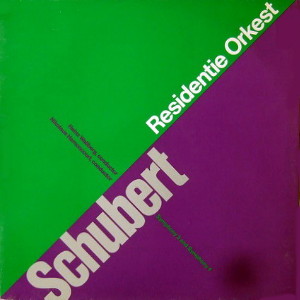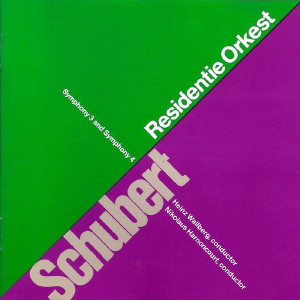 |
1 LP -
6818.661 - (p) 1985
|
 |
| 1 CD -
420 049-2 - (p) 1985 |
|
| Franz Schubert
(1797-1828) |
|
|
|
|
|
Symphony Nr. 3 in D major
(1815)
|
23' 21" |
|
| - Adagio Maestoso - Allegro
con brio |
9' 39" |
|
| - Allegretto |
4' 32" |
|
| - Menuetto: vivace |
4' 31" |
|
- Presto vivace
|
4' 39" |
|
|
|
|
Symphony Nr. 4 in C minor
(1816)
|
32' 38" |
|
- Adagio molto - Allegro
vivace
|
10' 39" |
|
- Andante
|
8' 12" |
|
- Menuetto: Allegro vivace
|
3' 15" |
|
- Allegro
|
10' 32" |
|
|
|
|
Symphony Nr. 4
|
Symphony Nr. 3 |
|
|
|
|
| Residentie
Orkest |
Residentie
Orkest |
|
| Nikolaus
Harnoncourt, conductor |
Heinz
Wallberg, conductor |
|
|
Luogo e data
di registrazione
|
Nieuwe Kerk, The Hague
(Olanda) - giugno 1983 (Symphony Nr. 4)
|
|
Registrazione
live / studio
|
| studio |
Producer / Engineer
|
Pubblication of the Hague
Philharmonic Orchestra
|
Prima Edizione
CD 
|
| Residentie-Orkest - 420 049-2
- (1 cd) - 56' 44" - (c) 1985 - DDD |
|
Prima
Edizione LP
|
Residentie-Orkest - 6818.661 -
(1 lp) - 56' 44" - (p) 1985 - Digitale
|
Note
|
-
|
|
| Notes |
|
Members of the Hague
Philharmonic play for their concert
hall
This series of
records is part of a project by which the
members of the Hague Philharmonic are
supporting the building of their concert
hall in The Hague. It is, as far as we are
aware, the first occasion in the
Nethertands on which employees have in
this way provided for the creation of
their own permanent place of work, in this
case a hall with good acoustics for
concerts, this being the ideal working
environment for an enterprising symphony
orchestra. The basic idea was that all the
workers on these records should not be
recorded live at a concert, but during
special recording sessions in the studio.
This requires a lot of extra time and
effort on the part of the orchestra. In
such cases the musicians therefore
normally receive so-called session fees
for this, as a result of which the
production of a symphonic record becomes
fairly expensive. The members of the Hague
Philharmonic have however forgone these
session fees in order to establish and
further exploit the hall so very necessary
for their work.
The Hague
Philharmonic
The Hague
Philharmonic, founded in 1904, has never
had a genuine concert hall of its own.
There began, particularly after the
destruction by fire ol the Arts and
Sciences Building in 1964, e dlscouraging
roving for the Hague orchestra from one
hall unsuitable for symphonic music to the
other. The need had in the and become so
great that the orchestra, at its wits'
end, decided in 1982 to start building a
concert hall ltself and at its own
expense. The fact that this hall is to be
opened as early as 1987 is partly due to
considerable support from industrial
circles the Government and private
persons. The publication of a series of
lp's, including the present one, is one al
the many means by which the orchestra is
itself raising money for the building of
its concert hall. In spite of its
accommodation problems the Hague
Philharmonic hu succeeded in developing
from a municipal ensemble to a symphony
orchestra of international proportions.
The Hague musicians have given concerts
from Norway to Greece and from Ireland to
Bulgaria. After six tours through the USA,
the Hague Philharmonic has also become a
highly respected orchestra in that
country. In recent years the Hague
Philharmonic has taken the lead in Dutch
orchestral life through its inventive
musical policy which has laid stress on
20th century and Dutch music. The amazing
success of two albums '400 Years of Dutch
Music' (36.000 copies of which have now
been sold) was a climax in this, which was
equalled by the notable 'From
concertseries', being pictures in sound of
pioneering composers or important trends
in music. The Hague orchestra also
discovered during the four popular 'Build
with us' festival 1982-1986 the extent to
which it knows itself to be supported
morally and materially by its music-loving
fellow-citizens.
Translation: Ian F.
Finlay and Fiona J. Gale
|
|
Nikolaus
Harnoncourt (1929-2016)
|

|

|
|